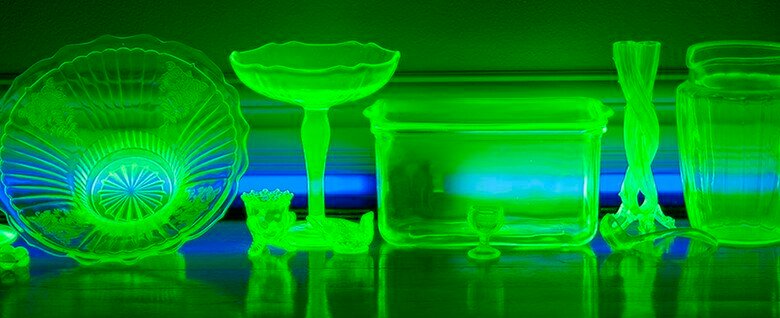ChatGPT said:

Uranium Glass: A Glowing Relic of the Atomic Age
Uranium glass, often known for its distinctive fluorescent green glow under ultraviolet light, is a type of glass that has small amounts of uranium—usually in the form of uranium oxide—added to its composition before melting. Although it might sound dangerous due to its radioactive element, uranium glass is generally considered safe to handle and has fascinated collectors and scientists alike for over a century.
History and Origins
The use of uranium compounds in glassmaking dates back to at least the early 19th century. Martin Klaproth, a German chemist who discovered uranium in 1789, noted the vibrant yellow-green hues uranium could produce when used as a pigment. By the mid-1800s, glassmakers in Europe began adding uranium to glass to create vivid shades of yellow, green, and even amber. These pieces were especially popular in Victorian decorative arts.
The golden age of uranium glass was between the 1880s and the 1940s. It was commonly used in tableware, jewelry, and household ornaments. Production slowed significantly during World War II, as uranium was diverted for use in the Manhattan Project and other wartime efforts. By the 1950s, regulations around radioactive materials tightened, further reducing the prevalence of uranium glass in everyday products.
Characteristics
- Color: Most uranium glass is green or yellow-green, though it can appear nearly colorless or even amber depending on the specific mixture and concentration.
- Fluorescence: One of the most unique aspects of uranium glass is its fluorescence. When exposed to UV light (black light), it glows a bright green due to the presence of uranium ions.
- Radioactivity: Uranium glass is mildly radioactive. The levels are low—typically not enough to pose a health hazard if handled normally—but it is detectable with a Geiger counter. Most pieces contain between 0.1% to 2% uranium by weight.
Uses and Collecting
Today, uranium glass is primarily a collector’s item. Enthusiasts seek out pieces for their aesthetic value, historical significance, and the novelty of their glow. Popular items include:
- Tableware (plates, bowls, cups)
- Vases and decorative ornaments
- Beads and costume jewelry
Collectors often use UV lights to identify genuine uranium glass, as the glow is a reliable indicator of uranium content.
Safety Considerations
While uranium glass is radioactive, experts generally agree that it is safe to own and handle, provided it’s not broken, ground, or inhaled as dust. Displaying and even occasional use of uranium glass tableware is considered low-risk. However, regular use for food or drink, especially with acidic substances, is discouraged as a precaution.
Modern Production
Though much less common, uranium glass is still produced today by select glassmakers, often for artistic or novelty purposes. These modern pieces tend to have lower uranium content due to stricter regulations, but they still retain the signature glow under UV light.
Conclusion
Uranium glass is a fascinating blend of art, science, and history. Its eerie glow, chemical composition, and ties to the atomic era make it a unique collectible and conversation piece. Though its production has diminished, the allure of uranium glass continues to shine brightly—especially under black light.



